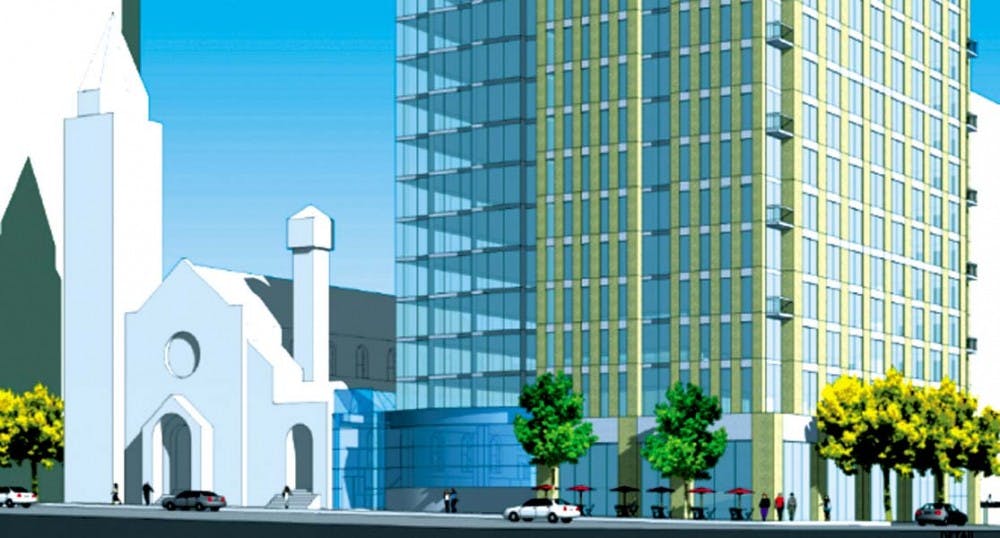
A 25-story highrise is set to be built at 38th and Chestnut streets by fall 2015. It will replace the two historic townhouses next to the Philadelphia Episcopal Church and the church hopes it will bring in revenue.
A 25-story high-rise development will soon replace two historic brownstones at the corner of 38th and Chestnut streets.
The tower will include apartments, church offices and retail space. The Philadelphia Episcopal Cathedral — located at 3723 Chestnut St. — hired Radnor Property Group to construct the new building and hopes to have it completed by the fall of 2015.
In their application for demolition to the Philadelphia Historical Commission, the cathedral contended that it does not currently produce sufficient income to support the preservation of the cathedral and its community programs and that they believe the new structure would provide essential facilities and funding.
The church hopes that this new building will bring in a steady stream of revenue that will enable the maintenance and preservation of the cathedral and its community programs and services.
The process began in April 2012 when the Philadelphia Cathedral sent a request to the Philadelphia Historical Commission for permission to tear down two historic townhouses owned by the church. The townhouses are located on the lots of 3723 and 3725 Chestnut St. and are known together as the parish house of the Episcopal Cathedral.
The two townhouses “are attractive and significant buildings designed by an important local architect, Charles M. Burns,” Aaron Wunsch, assistant professor of Landscape Architecture and Historic Preservation, said. The buildings were designated as historical landmarks in 1981.
“Their loss and the change in scale that will result from the new tower will significantly alter the feel and appearance of the area,” Wunsch added.
When the Philadelphia Historical Commission granted permission to the church to demolish these townhouses, not all community members were satisfied with the decision.
“We challenged the application [of the church] and appealed the decision of the Historical Commission,” Marian Kornilowicz, chair of the board of the Preservation Alliance of Greater Philadelphia, said.
The Preservation Alliance is a nonprofit preservation group that runs improvement, educational and advocacy programs in the region. As part of their advocacy programs, they get involved with projects that involve the preservation ordinance of Philadelphia in order to make sure that construction projects are consistent with the outlined laws.
In this case, the Historical Commission granted permission to the church to demolish the townhouses based on a city ordinance that says that no historic building can be demolished “unless the Commission finds that issuance of the building permit is necessary in the public interest.”
Executive Director of the Philadelphia Historical Commission Jonathan Farnham explained that permitting these demolitions was in the public interest because it “allowed the buildings of much lesser significance to be demolished to save the much more significant building, the church building.”
However, the Preservation Alliance felt that “public interest” ruled out “destroying two buildings in order to save a third.”
Despite this, “the Alliance rested its case because [the Historical Commission’s Board of License and Inspection Review] decided that the Alliance had failed to meet its burden of proof,” Farnham said.
The Alliance and the cathedral reached a settlement which consists of “a 50 year deal for the preservation of the cathedral and a commitment to the cathedral to maintain the building and continue using it as a place of ministry,” Kornilowicz said.
While preserving the cathedral was part of the original plan, “[it’s] another thing to commit to it in a document and have someone out there to enforce your commitment,” Kornilowicz added.
While the church now has the go-ahead to demolish the townhouse, some community members will lament the loss of the two significant structures.
“[The townhouses] could have been incorporated creatively into the high-rise the church wishes to build on the site, and the decision not to pursue that alternative is a sad missed opportunity,” Wunsch said. “Moreover, these buildings are listed in the local register. Their demolition … raises the question of how much protection such listing affords.”
The Daily Pennsylvanian is an independent, student-run newspaper. Please consider making a donation to support the coverage that shapes the University. Your generosity ensures a future of strong journalism at Penn.
DonatePlease note All comments are eligible for publication in The Daily Pennsylvanian.








